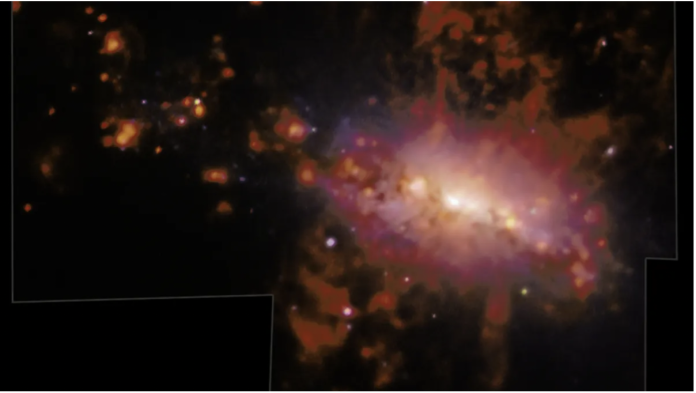
The discovery of a gas outflow or ‘Cosmic Fountain’ has been made in galaxy NGC 4383, located within the Virgo cluster. Researchers have revealed the outflow to be polluting intergalactic space with 50 million suns’ worth of material
Researchers revealed the gas outflow to be so big that light would take 20,000 years to travel from one side to the other and is moving at 450 times the top speed of a jet fighter.
The aftermath of stellar explosions
Led by Dr. Adam Watts from The University of Western Australia’s International Centre for Radio Astronomy Research (ICRAR), the researchers used these findings to look into the aftermath of powerful stellar explosions within NGC 4383’s central regions. They discovered that a cosmic fountain was ejecting huge amounts of hydrogen and heavy elements into space.
Dr. Watts explained, “Very little is known about the physics of outflows and their properties because outflows are very hard to detect.” This discovery offers a unique glimpse into the complex relationship between hydrogen and metals in galactic outflows.
Intense gas outflow
The scale of this gas outflow is intense, with the mass of ejected gas equivalent to more than 50 million Suns. “In this particular case, we detected oxygen, nitrogen, sulphur and many other chemical elements,” added Dr. Watts.
Gas outflows play an important role in regulating star formation within galaxies. As these explosions eject gas, they pollute the space between stars, slowing further star formation. This ejected material can drift into the intergalactic medium, affecting the dynamics of nearby galaxies permanently.
Using past research
Using high-resolution maps from the MAUVE survey, co-led by ICRAR researchers Professors Barbara Catinella and Luca Cortese, who also contributed to the study.
The MAUVE survey utilised the MUSE Integral Field Spectrograph on the European Southern Observatory’s Very Large Telescope in northern Chile.
“We designed MAUVE to investigate how physical processes such as gas outflows help stop star formation in galaxies,” explained Professor Catinella.
NGC 4383 was chosen as the initial target due to suspicions of fascinating activity, but the data exceeded expectations.
“We hope that in the future, MAUVE observations reveal the importance of gas outflows in the local Universe with exquisite detail,” expressed Professor Cortese.










